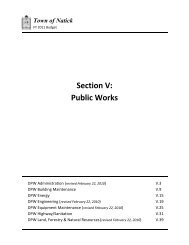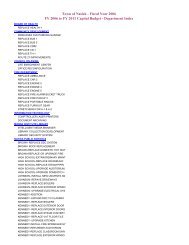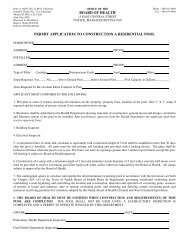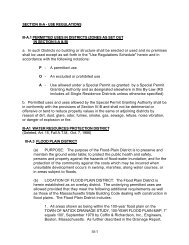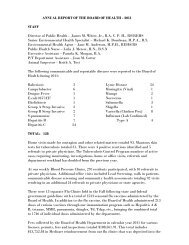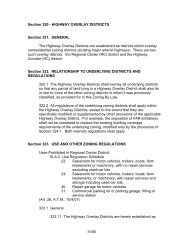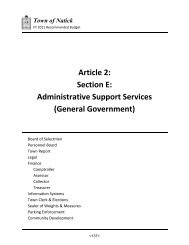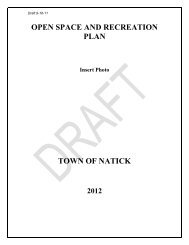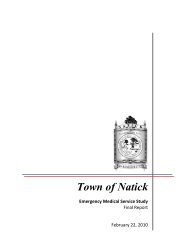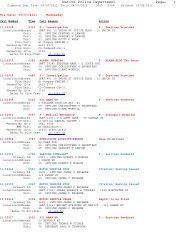TOWN OF NATICK Housing Production Plan
TOWN OF NATICK Housing Production Plan
TOWN OF NATICK Housing Production Plan
Create successful ePaper yourself
Turn your PDF publications into a flip-book with our unique Google optimized e-Paper software.
1400<br />
1200<br />
1000<br />
800<br />
600<br />
400<br />
200<br />
0<br />
2003<br />
2004<br />
2005<br />
2006<br />
2007<br />
2008<br />
Figure 7<br />
2009<br />
Source: Town of Natick Building Inspector<br />
Vacancy<br />
The Foundation for Growth created a working paper to project housing construction needs for<br />
the state under a variety of possible economic scenarios through the year 2020 (Lindsay<br />
Koshgarian; Lindsay Koshgarian, October 29, 2010). In their findings, they assumed that a<br />
healthy vacancy rate is defined as the rate at which prices neither rise nor fall, and has been<br />
estimated by the Harvard Joint Center for <strong>Housing</strong> Studies for the purposes of national housing<br />
projections to be 1.5 percent for owner‐occupied housing and 7.4 percent for rental housing<br />
(McCue, November 2007). The report stated that rental vacancy rate should be close to 7.4<br />
percent to avoid unnecessary price inflation.<br />
The report highlighted the following information:<br />
In 2008, Massachusetts had a shortage of 20,116 housing units statewide, if vacancy rates<br />
needed for healthy markets are considered.<br />
In 2008, the Boston Metro region had a shortage of 14,343 units, reflecting shortages in<br />
both single- and multi-family housing units, and 10,330 for multi-family units alone.<br />
Rental vacancy rates were lowest for multi‐family housing in Massachusetts in Metro<br />
Boston (4.5 percent).<br />
They forecasted population growth in Massachusetts from 2008-2020 is projected to be<br />
11.6% growth for person’s age 25 to 34 year old.<br />
They forecasted for Massachusetts a gap in housing supply of 33,775 multi-family units,<br />
including 20,651 in Greater Boston.<br />
In 2010, 5.1% of housing units in Natick were vacant, indicating that Natick has reached<br />
equilibrium in terms of supply and demand for housing. This vacancy rate, which has<br />
increased since 2000, is identical to that of Middlesex County and almost half the vacancy rate<br />
of the Commonwealth of Massachusetts, as shown in Table 24. It should be noted that the<br />
38 | P a g e L D S C o n s u l t i n g G r o u p , L L C<br />
2010<br />
2011<br />
1/12 to 4/12<br />
New Construction<br />
Alteration



